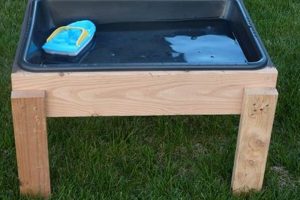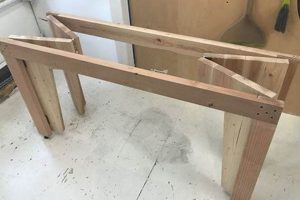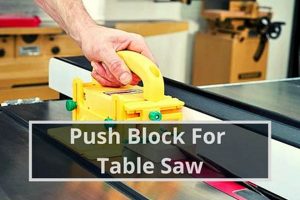A self-assembled table with a rising surface offers both storage and an elevated work or dining area within a compact footprint. These projects often involve modifying existing furniture or constructing a new piece from lumber and specialized hardware. The functionality allows the user to convert a standard coffee table into a more versatile item, suitable for activities beyond holding drinks and reading materials.
The appeal of creating such a multi-functional furniture piece lies in several advantages. It provides a space-saving solution, particularly valuable in smaller living areas. The internal storage beneath the rising top helps declutter living rooms. Furthermore, constructing furniture independently facilitates customization to match specific aesthetic preferences and dimensional requirements. Historically, the need for adaptable furniture has driven innovation in design, with lift-top mechanisms addressing the evolving needs of modern living.
The subsequent sections will explore various aspects of building a rising-surface table. These include design considerations, material selection, the mechanisms involved, detailed assembly processes, and potential challenges encountered during construction. Emphasis will be placed on achieving a durable and aesthetically pleasing result.
Construction Recommendations
The following recommendations provide guidance for successful construction of a rising-surface table. Careful planning and execution are essential for a functional and aesthetically pleasing outcome.
Tip 1: Precise Measurement and Planning: Accurate measurements are crucial prior to material cutting. A detailed plan or schematic prevents errors and ensures proper fit of all components. Consider the desired height of the elevated surface and available space.
Tip 2: Selection of Appropriate Hardware: The lift mechanism is a critical component. Choose a high-quality mechanism rated for the intended weight load. Ensure the chosen mechanism aligns with the design and functionality requirements.
Tip 3: Wood Selection and Preparation: Select lumber suitable for furniture construction. Hardwoods provide greater durability. Properly prepare the wood surface through sanding and priming before applying finishes.
Tip 4: Secure Fastening Techniques: Employ appropriate fasteners, such as screws or dowels, to ensure structural integrity. Glue joints can provide additional strength. Avoid over-tightening, which can damage the wood.
Tip 5: Gradual Assembly and Adjustment: Assemble the table gradually, checking alignment and functionality at each stage. Allow for adjustments as needed. Test the lift mechanism frequently during assembly.
Tip 6: Finishing and Protection: Apply a durable finish to protect the wood surface and enhance its aesthetic appeal. Consider the intended use and environment when selecting a finish. Allow adequate drying time.
Tip 7: Prioritize Safety: Wear appropriate safety equipment, such as eye protection and gloves, during all phases of construction. Use power tools according to manufacturer instructions. Secure the workpiece to prevent movement during cutting and assembly.
Adhering to these recommendations contributes to a robust and visually appealing final product, maximizing the benefits of constructing a rising-surface table.
The next section will address potential challenges encountered during the construction process and offer troubleshooting strategies.
1. Mechanism Functionality
The functionality of the lift mechanism is paramount to the utility of a self-assembled rising-surface table. This component dictates the smoothness, stability, and overall ease of use. A poorly functioning mechanism can render the entire table impractical, regardless of its aesthetic appeal or material quality. The mechanism’s primary role is to elevate the tabletop from its standard coffee table height to a more ergonomic level suitable for dining, working, or other activities. This elevation must occur without undue strain, noise, or instability. A malfunctioning mechanism introduces challenges to the table’s core purpose, diminishing its value as a multi-functional piece of furniture.
For example, a mechanism with insufficient load-bearing capacity may sag or fail under the weight of items placed on the tabletop. Similarly, a mechanism with rough or jerky movement can make it difficult to position the tabletop at the desired height. The selection of the appropriate mechanism requires careful consideration of the table’s dimensions, the intended weight load, and the desired range of motion. Furthermore, the ease of installation and adjustment of the mechanism are crucial factors in the construction process. Real-life examples of failures highlight the significance of investing in a high-quality, properly sized, and well-installed mechanism. Neglecting this aspect can lead to premature failure, requiring costly repairs or complete replacement of the rising-surface table.
In summary, the effectiveness of the rising-surface table is directly correlated to the operational quality of its lifting mechanism. Selection, installation, and maintenance of this component are crucial for realizing the intended functionality and maximizing the lifespan of the table. Potential challenges related to mechanism functionality include incorrect sizing, improper installation, and inadequate maintenance. Overcoming these challenges is essential to ensure the table delivers its intended benefits.
2. Material Durability
The longevity and functionality of a self-assembled rising-surface table are intrinsically linked to the durability of the materials employed in its construction. Material selection is not merely an aesthetic consideration; it directly impacts the structural integrity and lifespan of the furniture piece. Inferior materials can lead to premature wear, instability, and eventual failure of the table, negating the cost and effort invested in its creation. The cause-and-effect relationship is straightforward: durable materials withstand daily use and environmental factors, while less robust materials succumb to stress and degradation. For instance, using solid hardwood for the table frame and top provides superior resistance to warping, scratching, and denting compared to particleboard or low-density fiberboard.
The importance of material durability extends beyond structural stability. A durable finish protects the wood from moisture, stains, and UV damage, preserving its appearance over time. Hardware components, such as hinges and lift mechanisms, must also be constructed from robust materials to ensure smooth and reliable operation. A real-life example illustrates this point: a rising-surface table built with a lightweight softwood frame and a thin veneer tabletop may initially appear satisfactory, but it is unlikely to withstand the stresses of repeated lifting and lowering, as well as the weight of items placed on the surface. The veneer could chip, the frame could warp, and the lift mechanism could become strained, ultimately rendering the table unusable.
Understanding the relationship between material durability and the longevity of a self-assembled rising-surface table is of practical significance for any prospective builder. Prioritizing quality materials, even at a higher initial cost, ensures a more sustainable and functional piece of furniture that provides lasting value. Selecting appropriate materials demands consideration of intended use, environmental conditions, and desired aesthetic. Failure to recognize the importance of material durability poses a significant challenge to the successful creation of a functional and enduring rising-surface table. Overcoming this challenge requires informed decision-making and a commitment to using materials that meet the demands of long-term use.
3. Design Aesthetics
The aesthetic design of a self-constructed rising-surface table directly influences its integration into a living space. The visual appeal of the finished piece determines whether it complements or detracts from the overall decor. A well-designed table enhances the room’s ambience, while a poorly designed one can appear out of place, regardless of its functionality. The choice of wood, finish, hardware, and overall form are all critical elements that contribute to the table’s aesthetic impact. A cause-and-effect relationship exists: carefully considered design choices result in a visually pleasing and harmonious piece of furniture, whereas neglecting these considerations leads to a less desirable outcome.
Design aesthetics are not merely superficial; they contribute to the perceived value and usability of the rising-surface table. A table that is aesthetically pleasing is more likely to be used and appreciated. For example, a table crafted from reclaimed wood with a distressed finish might suit a rustic-themed living room, while a sleek, minimalist design with clean lines and a polished surface could better complement a modern space. A real-life example illustrates this point: a table with exposed hardware, mismatched wood tones, and an uneven finish might be structurally sound but visually unappealing, potentially deterring use. Conversely, a table with thoughtfully selected materials, a cohesive design, and a well-executed finish seamlessly blends into the room, enhancing its aesthetic appeal and increasing its functional value. Practical applications of this understanding include tailoring the design to match existing furniture, considering the room’s color palette, and ensuring that the table’s form factor is proportional to the surrounding space.
In summary, the aesthetic design of a self-built rising-surface table is integral to its success. Attending to details such as material selection, finish, and overall form ensures that the table not only functions effectively but also contributes positively to the visual environment. A key challenge is balancing personal preferences with the overall aesthetic of the room. Overcoming this challenge requires careful planning, attention to detail, and a willingness to adapt the design to achieve a harmonious and aesthetically pleasing result.
4. Storage Capacity
Storage capacity represents a core functional benefit intrinsically linked to the self-constructed rising-surface table concept. The availability of storage within the table directly addresses the need for space optimization, particularly in smaller living environments. A rising-surface table, absent sufficient storage, fails to fully capitalize on its potential for multi-functional utility. The addition of internal storage creates a dual-purpose piece of furniture, serving as both a surface for activities and a repository for items that would otherwise clutter the surrounding area. A cause-and-effect relationship is evident: increased storage capacity directly correlates with enhanced practicality and improved organization within the living space. Real-life examples include storing remote controls, magazines, blankets, or even work-related documents within the table, effectively decluttering the immediate area. The practical significance of this understanding lies in recognizing that maximizing storage capacity is a key design consideration, significantly impacting the overall value and desirability of the finished project.
Further analysis reveals that the type and configuration of storage within the rising-surface table are also crucial. A single, large open compartment may be suitable for larger items, while smaller, divided compartments can provide more organized storage for smaller objects. The accessibility of the storage area is also important. A design that requires excessive effort to access the stored items diminishes the convenience and practicality of the feature. For example, a rising-surface table with a hinged top that provides full access to the storage compartment is generally more functional than one with a sliding top that only provides partial access. Consideration should also be given to the weight-bearing capacity of the storage area’s floor and the durability of the hinges or other mechanisms used to access the storage.
In conclusion, storage capacity is a defining characteristic of a well-designed self-built rising-surface table, enhancing its utility and contributing to a more organized living space. The key challenge lies in optimizing the storage design to maximize space efficiency and accessibility, while maintaining the table’s structural integrity and aesthetic appeal. The integration of ample and well-designed storage directly contributes to the long-term satisfaction and practical value derived from the completed project, underscoring its importance as a fundamental element of the rising-surface table concept.
5. Assembly Precision
Assembly precision is paramount in the construction of a self-assembled rising-surface table. Deviations from accurate measurements and secure joinery can compromise the structural integrity, functionality, and aesthetic appeal of the finished piece. The following facets highlight the criticality of accurate assembly in this type of project.
- Hardware Alignment
Proper alignment of the lifting mechanism hardware is crucial for smooth and reliable operation. Misaligned hinges, brackets, or gas springs can cause binding, uneven lifting, and premature wear. The instructions provided with the lift mechanism must be followed precisely. Failure to adhere to these instructions can lead to a malfunctioning or unstable table. An example of this is when the screws are not perpendicular and not secure to the surface, this is critical issue for assembly precision.
- Joint Integrity
The strength and stability of the table depend on well-executed joints. Accurate cuts, proper clamping, and appropriate adhesives are necessary to ensure that the frame and tabletop are securely connected. Weak joints can lead to wobbling, sagging, or even complete separation of components. The application of excessive clamping force or using the wrong type of adhesive can also compromise the joint’s integrity. Joint integrity is one of the main core for assembly precision.
- Surface Alignment
Maintaining consistent surface alignment is essential for both aesthetic appeal and functional use. Uneven surfaces can be unsightly and can also create difficulties when using the table as a work surface or for dining. Precise cutting and careful assembly are required to ensure that the tabletop is level and that all edges are flush. Surface alignment is one of the important factors when assembly precision is consider.
- Dimensional Accuracy
Adhering to specified dimensions is critical for ensuring that all components fit together correctly and that the finished table meets the intended size requirements. Even minor deviations from the planned dimensions can accumulate and create significant problems during assembly. Careful measurement, precise cutting, and consistent attention to detail are necessary to achieve dimensional accuracy. This is very important because, its directly correlated to the size or dimension you design. Dimensional accuracy should be consider for assembly precision.
These facets underscore the importance of assembly precision in the construction of a self-assembled rising-surface table. A commitment to accuracy and attention to detail throughout the assembly process is essential for creating a functional, durable, and aesthetically pleasing piece of furniture. While design and material selection are important, the ultimate success of the project hinges on the precision with which it is assembled.
6. Ergonomic Height
The ergonomic height of a rising-surface table is critical to its usability and the physical well-being of its users. A table that is not at an appropriate height can cause discomfort, strain, and even long-term health problems. Therefore, careful consideration of ergonomic principles is essential when designing and constructing such a table.
- Work Surface Height
The height of the elevated work surface should be conducive to comfortable working or dining. For most adults, a height of 28 to 30 inches is suitable for dining, while a height of 30 to 32 inches is preferable for computer work. These heights allow for proper posture, reducing strain on the neck, back, and wrists. For example, using a rising-surface table set too low can lead to slouching, while using one set too high can cause shoulder and neck tension.
- Adjustability Range
The range of adjustability of the lift mechanism determines the versatility of the table. A mechanism that offers a wider range allows the table to accommodate users of different heights and to be used for various activities. For instance, a table with a limited range may only be suitable for dining, while a table with a wider range can also be used for working or hobbies. It should be consider the heights of people using the table, and the range needed.
- Seating Considerations
The height of the table should be compatible with the seating used with it. Standard dining chairs typically have a seat height of 18 inches, while bar stools have a seat height of 30 inches. The table height should allow for comfortable legroom and a natural arm position when seated. For example, if the rising-surface table is being used with bar stools, the elevated height should be adjusted accordingly.
- User Customization
Ultimately, ergonomic height is subjective and depends on individual preferences and needs. Allowing for user customization is key to ensuring maximum comfort and usability. This can be achieved through a lift mechanism that allows for incremental height adjustments or through the use of shims or spacers to fine-tune the height. It is important to test different heights and find the one that feels most comfortable and natural.
In conclusion, ergonomic height is a fundamental design consideration for a self-constructed rising-surface table. By carefully considering work surface height, adjustability range, seating considerations, and user customization, a table can be created that promotes comfort, reduces strain, and enhances the overall user experience. A failure to properly account for ergonomic principles will decrease the value of the table.
7. Structural Stability
Structural stability is a non-negotiable attribute of any self-assembled rising-surface table. The capacity of the table to withstand applied loads, resist deformation, and maintain its intended geometry is paramount. A lack of structural integrity poses safety risks and undermines the functional purpose of the furniture. The cause-and-effect relationship is direct: inadequate structural design results in a table prone to wobbling, sagging, or even catastrophic failure, while robust structural engineering yields a stable and durable piece. For instance, a rising-surface table constructed with insufficient bracing or undersized support members is susceptible to collapse under the weight of objects placed on its surface or during the lifting and lowering process. The practical significance of this understanding cannot be overstated: prioritizing structural stability during the design and construction phases is essential for ensuring the longevity, safety, and utility of the table.
Further analysis reveals that structural stability is influenced by several factors, including material selection, joint construction, and the design of the supporting framework. The use of high-quality, rigid materials, such as hardwoods or steel, contributes significantly to overall stability. Secure and properly executed joints, such as mortise-and-tenon or dowel joints, provide resistance to shear and tensile forces. A well-designed framework, incorporating strategically placed braces and supports, distributes loads evenly and prevents deformation. Practical applications of these principles include selecting appropriate lumber grades, employing robust joinery techniques, and incorporating triangular bracing to enhance rigidity. For example, a table with a solid wood frame, reinforced corners, and a properly sized lift mechanism is more likely to exhibit superior structural stability compared to a table constructed from lightweight materials and assembled with weak joints.
In summary, structural stability is a critical determinant of the success of a self-built rising-surface table. Ensuring adequate stability requires careful consideration of material selection, joint construction, and framework design. The key challenge lies in balancing aesthetic considerations with the need for structural integrity. A well-designed and properly constructed table that prioritizes structural stability will provide years of reliable service, underscoring the importance of this fundamental attribute. The integration of robust structural elements is essential to maintain stability, enhance the durability, and extend the use.
Frequently Asked Questions
The following addresses common inquiries regarding the construction of self-assembled rising-surface tables. The information provided aims to clarify key aspects of the process and mitigate potential challenges.
Question 1: What distinguishes a high-quality lift mechanism?
A superior mechanism exhibits smooth, consistent operation across its entire range of motion. It should be rated for a weight load exceeding the intended maximum, constructed from durable materials, and possess a reliable locking system to prevent unintended descent.
Question 2: Which wood species are most suitable for frame construction?
Hardwoods such as oak, maple, or walnut offer superior strength and resistance to warping compared to softwoods like pine. While softwoods may be acceptable for non-load-bearing components, hardwoods are recommended for the frame and supporting structure.
Question 3: How is proper joint integrity achieved during assembly?
Proper joint integrity is achieved through precise cuts, careful alignment, and the use of appropriate adhesives and fasteners. Mortise-and-tenon joints, dowel joints, or pocket-hole screws, when combined with wood glue, provide robust and reliable connections.
Question 4: How is the risk of table instability mitigated?
Instability is mitigated by employing a robust frame design, incorporating diagonal bracing, and ensuring that all joints are securely fastened. The lift mechanism should also be properly installed and adjusted to distribute weight evenly.
Question 5: What safety precautions are essential during construction?
Essential safety precautions include wearing appropriate eye protection, using power tools according to manufacturer instructions, securing the workpiece to prevent movement, and working in a well-ventilated area when applying finishes.
Question 6: How is the aesthetic integration of the table ensured within a given space?
Aesthetic integration is achieved by carefully considering the existing dcor, selecting materials and finishes that complement the room’s color palette, and ensuring that the table’s form factor is proportional to the surrounding furniture.
These FAQs provide a foundation for understanding critical aspects of rising-surface table construction, fostering informed decision-making throughout the project.
The subsequent section delves into common pitfalls and strategies for troubleshooting challenges encountered during the assembly process.
Conclusion
The preceding exploration underscores the multifaceted considerations inherent in the construction of a diy lift top coffee table. Factors ranging from mechanism selection and material durability to design aesthetics, storage optimization, assembly precision, ergonomic principles, and structural stability collectively determine the success of the project. A comprehensive understanding of these elements is crucial for achieving a functional and aesthetically integrated furniture piece.
The successful creation of a diy lift top coffee table represents more than simply assembling a piece of furniture. It demonstrates skillful application of design principles and construction techniques. Therefore, the aforementioned information should serve as a valuable resource, guiding builders toward well-informed decisions and promoting the creation of durable and versatile furniture.







